Pruning for disease management and yield benefits in hops
Pruning hops may help manage halo blight.

An important agronomic practice in established hop yards (generally at least two years of age) is spring removal of plant and crown material. This is generically referred to as pruning, which can be conducted using mechanical or chemical means. According to “Compendium of Hop Diseases and Pests” by W.F. Mahaffee, S.J. Pethybridge, and D.H. Gent, because many of the terms are used interchangeably, it is useful to define the different methods that growers use to remove bines, buds, and new young shoots. Mechanical pruning generally refers to removal of shoots from the current or previous season and associated crown buds by physical means. There are multiple ways of mechanical pruning, such as crowning or cutting, or a less aggressive form referred to as scratching. Crowning involves removal of the top 0.75-2 inches of the new wood formed in the previous season (i.e., part of the crown) with an offset implement (see Figures 1-2).
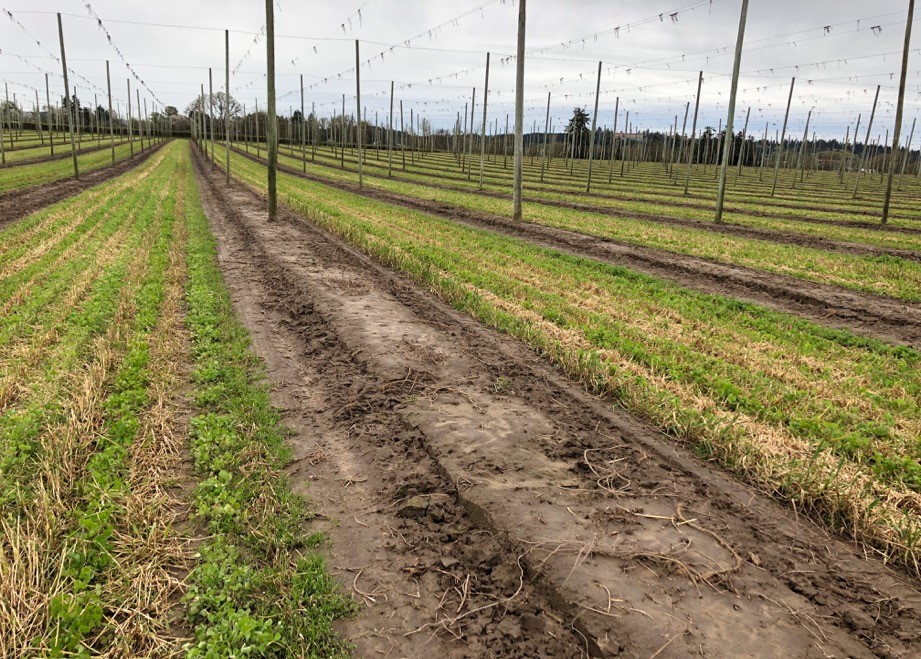
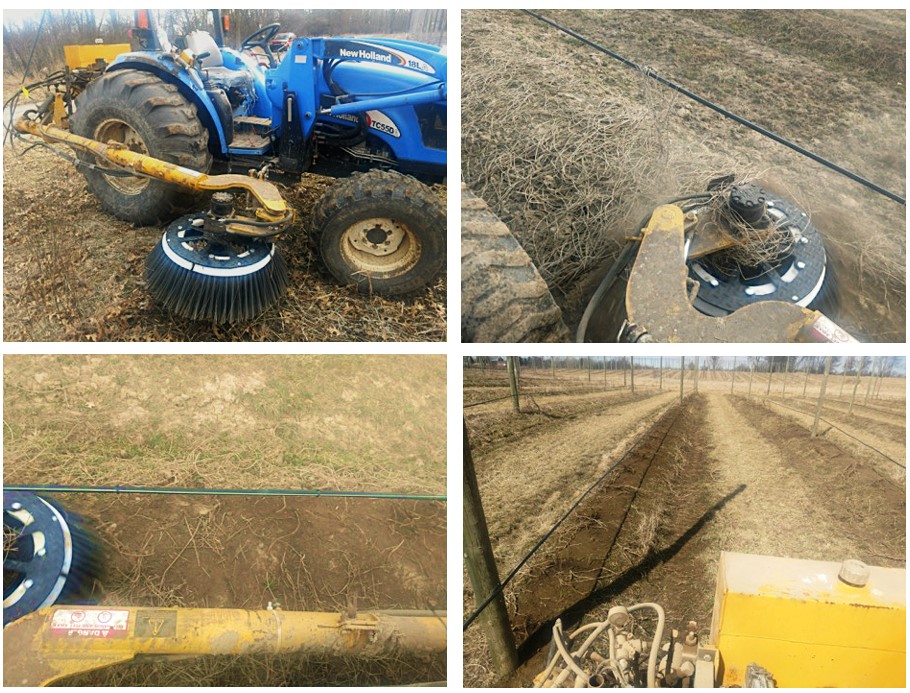
Scratching involves using a “harrow-like” implement with spinning discs and tongs to remove material above or just below the soil line (Figure 4).
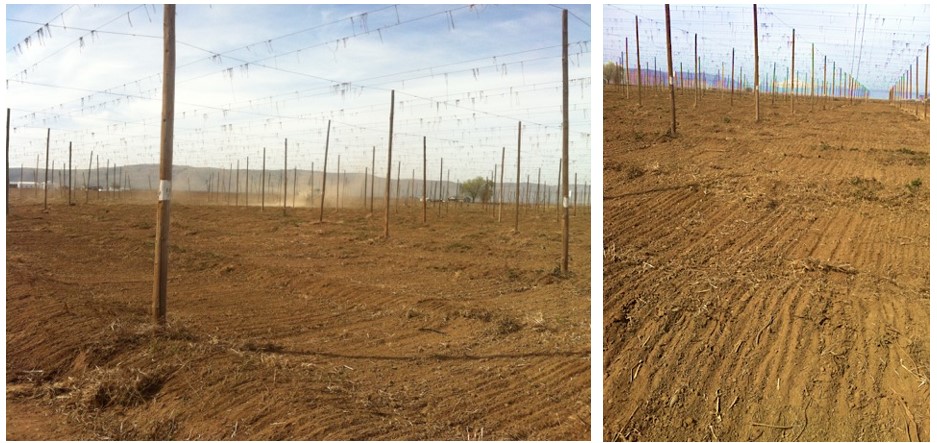
Historically, hop producers in regions of Europe and the western U.S. that experience high disease pressure usually “crown” in late winter to early spring to reduce downy and powdery mildew inoculum. Depending on variety and weather, producers may follow up with chemical or mechanical pruning later in spring after the first shoots emerge. Growers who crown typically have “hilled-up” soil on the crowns the previous growing season (for example, in mid- to late June). Less aggressive mechanical pruning methods such as scratching do not require annual hilling of soil.
While both crowning and other forms of mechanical pruning are useful for reducing mildew disease inoculum, viruses can be spread to adjacent plants through mechanical transmission. According to research published in Plant Disease in 2016 and 2018, chemical pruning with a desiccant herbicide such as carfentrazone-ethyl (AIM) can help limit the spread of virus, but any green tissue and or infected left behind may shelter inoculum if disease pressure was severe the previous year.
In 2012, researchers from the Pacific Northwest analyzed survey data from 149 hop yards in Oregon and Washington to assess the association between the thoroughness of spring pruning, timing of pruning operations, and the severity of downy and powdery mildews. The most common pruning approach was chemical desiccation (48% of yards), mechanical pruning (23%), or a combination of these practices (15%). Pruning quality was rated as excellent, moderate or poor based upon the amount foliage remaining post-pruning. Producers who indicated they pruned twice were much more likely to receive an excellent rating compared to growers who only pruned once. Downy mildew severity in Oregon increased twofold as pruning quality dropped from excellent to poor. While pruning quality had no significant effect on powdery mildew in Oregon, increased seasonal severity of powdery mildew on leaves and incidence on cones was greater in yards with poor pruning in Washington. Depending upon timing and quality of pruning, growers may be able to eliminate one fungicide application per year. D.H. Gent and colleagues concluded that, “…early spring sanitation measures are associated with reduced primary inoculum and are critically important for managing both downy mildew and powdery mildew.”
More recently, Oregon State University and Washington State University researchers studied the effect of pruning timing and method on powdery mildew development, yield, and hop quality in a commercial hop yard of Tomahawk in Washington. They found that a four-week delay in pruning reduced powdery mildew incidence on leaves from 46% to 10% and on cones from 9% to 1%. There was no significant difference in powdery mildew incidence on leaves when pruning method was compared (chemical versus mechanical). Delayed pruning for multiple years did not negatively affect cone yield, quality or appearance.
Pruning may offer growers a tool in their battle against halo blight (caused by Diaporthe humulicola). Recently this disease has been reported in Michigan, Connecticut and Quebec. Halo blight causes brown leaf lesions surrounded by a halo of chlorotic tissue, browning of cone bracts, and eventual shatter of hop cones. Yield losses can be extreme. Cone symptoms and signs can include necrosis on the terminal end of the cone, girdling of the cone, cone dryness and/or small black pimple-like structures (pycnidia) in the bract tissue (Figure 5). In 2020, we began to visualize overwintering pycnidia in the spring in yards that had halo blight (Figure 6). Early research suggests that mechanical control (scratching) and chemical options may help growers control halo blight. Chemical treatments for powdery mildew may provide some control throughout the season, particularly if fungicides are in FRAC codes 3, 7 and 11). Consult the Hop Management Guide for more information.
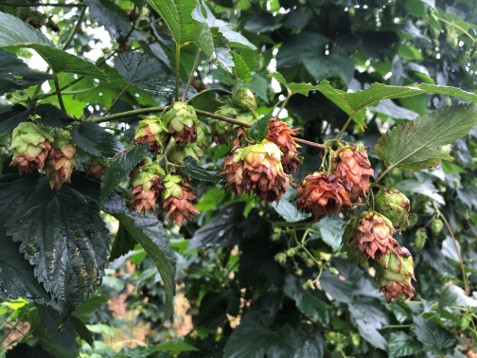
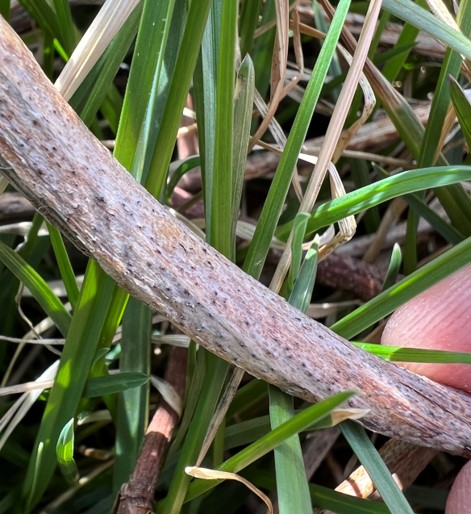
Another advantage of chemical or mechanical pruning to remove young shoots is uniformity of secondary growth in the run up to training. Because the pruning date affects training date, which is of utmost important for yield, pruning at the appropriate time is critical. To complicate matters, pruning date is cultivar dependent (Table 1).
|
Table 1. Approximate chemical pruning, training and harvest dates by variety in Washington State. Note that these pruning and training dates may not be relevant for other production regions. Source: Sarah Del Moro. | |||
|---|---|---|---|
|
Variety |
Chemical Pruning Dates |
Training Dates |
Harvest Dates |
|
Willamette |
4-12 |
5-1 / 5-3 |
8-24 / 8-29 |
|
Cascade |
4-12 |
5-4 / 5-7 |
9-3 / 9-23 |
|
Cluster |
4-17 |
5-7 / 5-8 |
8-29 / 9-10 |
|
Millenium |
4-18 |
5/10 |
9-3 / 9-28 |
|
Citra |
4-18 / 4-26 |
5-10 / 5-15 |
9-3 / 9-18 |
|
Equinox |
4-26 |
5-16 / 5-17 |
9-20 / 9-23 |
|
Mosaic |
4-26 / 4-28 |
5-15 / 5-20 |
9 -5 / 9-23 |
|
Zeus |
4-28 / 4-30 |
5-19 / 5-20 |
9-3 / 9-30 |
Researchers in the Czech Republic investigated the effect of pruning time on yields and alpha acid content for the hop cultivar Agnus. The project defined early pruning as the end of March, mid pruning as the first 10 days in April, and late pruning as the second ten days in April. They found that later pruning conferred greater yields and alpha acid content than early or mid-pruning. Timing will likely vary annually based upon the plant phenology and location.
In general, hop plants will regrow and are ready to train approximately three to four weeks after pruning, depending on how pruning was conducted. Slower growing cultivars and yards with poor vigor may need to be pruned earlier, or not at all, to ensure adequate growth and maximum yield.
Pruning is an important agronomic practice that can have a major impact on hop yield and quality. Methods and timing of pruning will depend upon grower preference, irrigation placement and practice, cultivar, vigor of the yard, yard age, latitude and location, timing, disease severity from the previous season, and seasonal growing conditions after the operations. There is no substitute for local trials and experience to determine the optimum method and timing of pruning operation. When producing a new variety, it is advisable to experiment with varying pruning dates (and by consequence then, training dates) over a period of several weeks to observe how plants respond.
For more information on hop production practices, sign up for the FREE MSU Hop Chat Series.
Hop Crown Mower
DK FAB Hop Crowner
Spring Work in Oregon Hop Fields
Scratching in WA
Please continue to visit Michigan State University Extension's Hops website or the MSU Hops News Facebook site for up to date information.
Thanks to Erin Lizotte and Dave Gent for information and photos included in this article.
This work is supported by the Crop Protection and Pest Management Program [grant no 2021- 70006-35450] from the USDA National Institute of Food and Agriculture and the North Central IPM Center. Any opinions, findings, conclusions or recommendations expressed in this publication are those of the author(s) and do not necessarily reflect the view of the U.S. Department of Agriculture.



 Print
Print Email
Email




